| Reviews & Columns |
|
Reviews DVD TV on DVD Blu-ray 4K UHD International DVDs In Theaters Reviews by Studio Video Games Features Collector Series DVDs Easter Egg Database Interviews DVD Talk Radio Feature Articles Columns Anime Talk DVD Savant Horror DVDs The M.O.D. Squad Art House HD Talk Silent DVD
|
DVD Talk Forum |
|
|
| Resources |
|
DVD Price Search Customer Service #'s RCE Info Links |
|
Columns
|
|
|
Gangs of New York
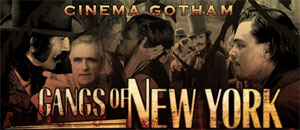
Read more about Gangs of New York at Cinema Gotham
December 12, 2002 | Martin Scorsese's tremendous Gangs of New York is a film of hugeness. It's based on a 74 year-old book (Herbert Asbury's "The Gangs of New York"), which the director spent three decades trying to bring to the screen. It was delayed for over a year before its release. The sets are enormous. The cast is seemingly infinite. And the violence is painful to watch.
But it's also a film of human proportions. It's the story of a father and a son, a man and a woman, a teacher and a student. The emotions it strives for are very common and very real. The agony, the anguish, the longing are as contemporary as the details of the setting are obsolete. Scorsese has taken the enormous setting of his film and injected into it some classic film storylines. Revenge, betrayal and love are all themes here and if anyone takes issue with the film it will be over Scorsese's use of these standard plot devices.
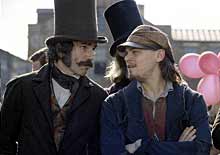 Day-Lewis and DiCaprio |
The story hinges on the fictional character of Amsterdam Vallon (Leonardo DiCaprio) whose father Prince Vallon (Liam Neeson) is killed early on by Bill the Butcher Cutting (Daniel Day-Lewis). After growing up in an institution outside of the city, Amsterdam returns to the Five Points with revenge on his mind. the boy's absence, however, Bill consolidates his control over the rabble, outlawing Vallon's gang (the Dead Rabbits) and is pretty much running the show. Amsterdam has no choice but to join Bill's ranks. As he gets closer to Bill the question becomes: Does he still want to kill his father's killer or have things become more complex?
Surrounding this plot with the intense historical and social observations of Herbert Asbury's book was a great move. The film, having been cut down from well over four hours to the two hour 38 minute running time hitting theaters, necessarily leaves out quite a bit. It feels as if the love interest relationship between DiCaprio and Cameron Diaz as pickpocket Jenny Everdeane has been whittled down a bit. And some key supporting characters have probably lost some material. Like Peter Jackson's Lord of the Rings: The Fellowship of the Rings, this is a totally engaging film that could still stand to be expanded further. Even though the intensity of the battles and the extreme level of poverty on display can be exhausting, Scorsese's joy and wizardry at recreating the era make the film seem far shorter than its length.
That's not to say that it's a fun ride all the way. Gangs of New York begins in a flurry of dark, brooding imagery. Men prepare for battle, storming through the caverns of some decrepit hell like Jake LaMotta approaching the boxing ring. They're accompanied by hard women and filthy children and menacing tribal rhythms. When they emerge into the blinding, snowy daylight they stand shoulder-to-shoulder awaiting a battle. And that battle comes swiftly, in one of the most bloody, stunningly visceral sequences ever committed to film. The rapidity of the cutting, the realism of the violence, the level of chaos all combine in an extraordinary way. By the time the battle is done and the camera retreats (through a series of pull-backs and dissolves) the audience could believe that it is seeing some medieval society in the midst of some territorial struggle.
But when the cameras pull back the shape of the land is unmistakable as the southern tip of Manhattan island and anyone who doesn't already know that this film takes place in New York City is in for a real surprise.
This opening sequence stands along with the director?s finest moments. Everything in it is perfect. The frantic pacing and the combination of music and images are just spectacular. There are a few amazing sequences in the film, including the heartbreaking shot that starts showing immigrants streaming off a ship, signing citizenship documents, being shuttled off to Army recruiters, handed guns and uniforms, being separated from their families and herded onto another ship headed straight down to the front-lines of the Civil War. They are told to fight for their country, a country they've been in for less than a minute. When this epic shot ends, on hundreds of caskets being removed from the same war-bound ships, Scorsese has summed up the entire tragic American experience of thousands.
Visual flourishes like this aren't just great to look at. They're integral to Scorsese's storytelling style. He's always used visual cues and vehicles to develop the character of his films, from Travis Bickle's cab to Raging Bull's boxing rings to the lavish houses of Age of Innocence, he's always used the specifics of his subject matter to the fullest. Gangs of New York follows this tradition. The weapons, the wardrobe, every fiber of the film creates the texture of the film. Taken together with Michael Ballhaus' dense, detailed cinematography, Thelma Schoonmaker's razor-sharp editing, exquisite blending of set design and CG embellishment and the diverse score taken from many period and modern sources, make Gangs of New York one of the most cinematic journeys in years.
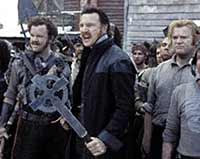 Reilly, Neeson and Gleeson |
Henry Thomas plays Amsterdam's best friend Johnny as the type of good guy that grows up in the Five Points: Reliable as a friend but without a real strict moral code. Gleeson's Monk (not actually based on real-life gangster Monk Eastman) is another fantastic, subtle performance that seems to have lost a bit of detail in the film's editing. He's a strong figure who symbolizes the changes the Five Points and New York go through during the course of the film. When he and Neeson come face to face in the film's opening, the two Irish actors bristle with chemistry. It's a shame that they have so little screen time together but both make the most of it.
Of the leads, only Daniel Day-Lewis really dazzles. His Bill the Butcher is a singular achievement in film acting. There was a real Bill the Butcher (his last name was Poole) and Day-Lewis' performance incorporates many of his traits (his expertise with knives, his strict alliance with the anti-immigrant Native American gang, his towering presence) but he also creates the character for himself. Day-Lewis' Bill is an amazing character. At times he's actually almost tender and he also portrays a sense of loyalty and dignity. He shows a deep respect for Amsterdam's father, which seems to run contrary to criminal Bill described in Asbury's book.
Day-Lewis stylizes the performance in a way that the man his character is loosely based on would probably have appreciated. His power is based on the interplay between his glowering anger and his sneering smile and Day-Lewis gets both frighteningly right. He's always been able to shape-shift as needed, through films as diverse as My Left Foot, The Boxer, A Room With A View and Scorsese's own The Age of Innocence, but never before (with the exception of In the Name of the Father) has his performance shifted so much during the course of one film. In In the Name of the Father Day-Lewis' character matured on screen until the man at the film's end was barely recognizable as the foolish young man from the opening scenes. Bill the Butcher doesn't grow in the same way but rather changes from scene to scene. He's a strange, unique character who goes from respectful and proud to cleverly funny to horrifying ugly, sometimes within seconds. His bizarre looks (thick mustache, huge hats, glass eye) and the air of danger that clings to him make this one of the performances of the year.
Scorsese uses the Butcher in a smart way. The original Bill the Butcher was basically a thug, running his nativist gang from what is today the West Village and fighting off the immigrant gangs of the Five Points. In the film, however, Bill is a much richer character who holds the memory of Prince Vallon in high regard as the only man he ever killed worth remembering. He drapes himself in the American flag and makes proclamations about the direction the nation is headed. He's a hurricane force in the film from his first stunning appearance through to his famous final words.
The two heartthrob leads, however, don't fit their roles quite as well. DiCaprio is solid as Amsterdam but doesn't quite have the dramatic weight to pull off the role. He's better than expected but never quite fully embodies the anger and anguish of the character. Still, he looks the part and does the job. His accent comes and goes, although his character is not supposed to be Irish but rather first generation Irish-American living in a place where the number of different accents boggles the ears, so it works. Amsterdam is an uncertain protagonist. He may have a goal but that's not to say that he's single-minded. His relationships with Bill and Jenny are unsteady and DiCaprio is good at projecting the uneasiness of a young man thrown into a situation he can't possibly control.
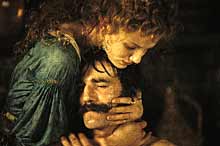 Diaz and Day-Lewis |
The casting and plotting stumbles that Scorsese makes are the by-products of his boldness. Gangs of New York is an enormous tapestry that covers tremendous emotional, historical and logistical ground, and it surely needed some big names to get made. If the alternative was to go with less well-known actors but to shrink the scope of the production, then Scorsese made the right choice. The thing that made Titanic at least worth a look was that, despite the tin-eared dialog and often overly simplistic emotional core, it was in essence a very simple fictional story wrapped in an provocative real-life drama. Well, the real-life drama in the equally enormous Gangs of New York (certainly in level of ambition if not in budget) is infinitely more desperate and provocative and the emotional core of the story infinitely more engaging.
By wrapping his film in the struggle of immigrant groups and the opposition of nativists, Scorsese cuts to the heart of what made the period important while keeping the film dynamic and vibrant. It's hard for most people to imagine the kind of chaotic mix of cultures represented in the film but they are portrayed vividly. The multiple musical styles, countless accents and languages and styles of dress all blend together to create a complex, deep world that the viewer can complete get enveloped up in.
Another theme of Gangs of New York is how the past gets forgotten. The New York of today is a neon jungle bordering on soulless, filled with Starbucks and Duane Reades. The New York of the middle of the 19th Century, however, was a place of tremendous, unimaginable suffering. In "The Gangs of New York" Herbert Asbury describes the city as "really wicked." He saves some of his most vivid writing for a neighborhood that doesn't even exist anymore called the Five Points. This small neighborhood was home to some incredible poverty. Asbury recounts some pretty horrific tales of the Five Points, like the little beggar girl murdered over a penny she'd just been given and then left in a corner to rot.
The Five Points is the focus of Scorsese's film, which, the credits state, was "suggested" by Asbury's book. Along with screenwriters Jay Cocks (who also is credited with the story), Steven Zallian and Kenneth Lonergan, Scorsese knows exactly what to do with all this historical and cultural context. The film is filled with layers and can be compared with modern day New York and America in numerous ways. Many of the struggles, between the law and the citizenry, between the battling police departments (there were two at the time) and between New York and the rest of the nation and the world are all ideas that have in some way carried through time.
The film's climax hauntingly uses the infamous Draft Riots as a backdrop, almost as a rhythmic score to the story's final showdown. The Draft Riots were begun as a serious protest against the classist Civil War Conscription Act, which allowed anyone with $300 (a huge sum at the time) to opt out of the draft. However, they quickly became a shameful, disgraceful free-for-all, complete with lynchings of blacks and wanton destruction of people and property. The huge mob kept the city in flames for days.
In one brilliant stroke, Scorsese identifies the locations of many of the main foci of the Draft Riots with onscreen text. This adds to the urgency and realism of the sequence but it's also key to understanding the riot. The big difference between these locations and other significant sites of American bloodshed like, say the Alamo, is that these locations are not landmarks. They, like the rest of the city, have been built over and built over again. For a city that can't keep from swallowing itself whenever it gets the least bit hungry these location cues come as a shock. The addresses are where people now go to work, have their homes, do their shopping. But in the 1860s there was unimaginable chaos. And when the Draft Riots essentially end in the film it is in a way that reminds the viewer how isolated these New York combatants have kept themselves from the outside world and how devastating it can be when that world comes calling.
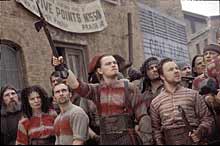 The Dead Rabbits |
It's unlikely that another film will come along soon with the brutal power of Gangs of New York. Scorsese's finest films cover a broad range of subject matter, from Mean Streets to Raging Bull to King of Comedy to Gangs of New York they share a willingness to bathe their characters' emotions in the blood of conflict rather than draw a line between the internal and the external. Gangs of New York in many ways reaches new highs for the director in this respect. In a way it combines the explosion of personal demons seen in Taxi Driver's final reels with the emotional violence glimpsed in Age of Innocence. There is no difference, Bill the Butcher might say, between cutting a man's flesh and killing his soul.
Gangs of New York opens December 20.
CLICK HERE TO READ WHAT YOU NEED TO KNOW BEFORE SEEING GANGS OF NEW YORK.

|
| Popular Reviews |
| Sponsored Links |
|
|
| Sponsored Links |
|
|
| Release List | Reviews | Shop | Newsletter | Forum | DVD Giveaways | Blu-Ray | Advertise |
|
Copyright 2024 DVDTalk.com All Rights Reserved. Legal Info, Privacy Policy, Terms of Use,
Manage Preferences,
Your Privacy Choices | |||||||











